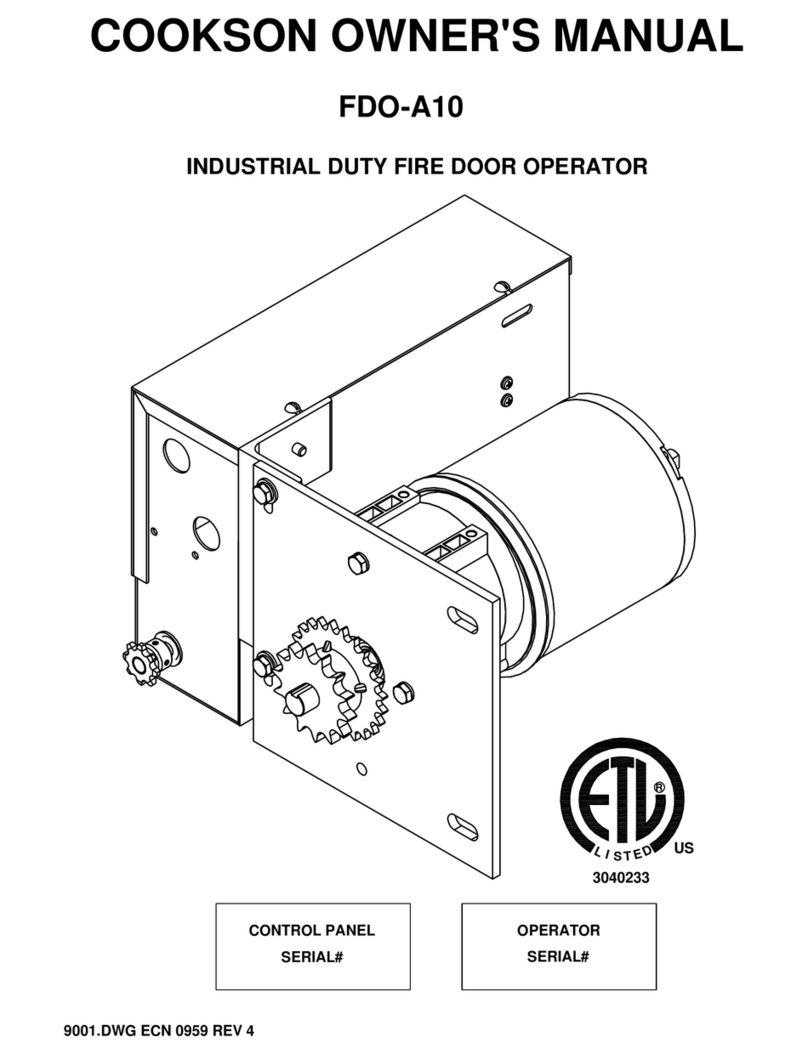
4
AC power. The battery is checked for presence once an
hour for 10 seconds. If this test fails, the battery has
failed or is significantly depleted. A major fault (see “a”
and “b” examples) is declared and must be immediately
rectified. The battery is also load tested for five minutes.
The five minute load test is performed once per week to
ensure that the power remaining in the batteries is
sufficient to handle an emergency condition. The test will
occur within 12 hours of a power outage or an aborted
test due to user input.
The severity of the battery test failures are defined as a
minor fault and a major fault and are described as
follows:
a. Minor Fault. This fault mode occurs when the system
determines that the batteries fail to maintain the
minimum voltage between 10 seconds and 5 minutes
of load testing. The alarm within operator will begin
notification immediately at 3 seconds per minute. The
batteries will be retested every week. The controller
will attempt to close the door after 45 days of
notification and test failures.
b. Major Fault. This fault mode occurs when the system
determines the batteries fail to maintain the minimum
voltage for less than 10 seconds of load testing. The
batteries are either not connected or are significantly
depleted. The system will attempt to close the door
after the DIP switch selected alarm delay. (See DIP
Switch section of this manual.) Notification will occur
as a 1 second on 1 second off pulse train until Battery
Test passes.
Whenever a battery failure occurs, the batteries must be
connected or replaced immediately in order to ensure
normal system operation. If for any reason the battery
voltage drops below the minimum voltage, the unit will
activate the optional warning system and automatically
close the door via a controlled descent.
If the system passes the Battery Test, then all alarms are
cleared.
Battery Disposal
Replaced batteries must be treated as a hazardous waste
and disposed on in accordance with State, Local and
Federal Regulations. See the battery manufacturer’s
Material Safety Data Sheets (01-30839 "MSDS Sheets,
Battery, Standard").
Battery Replacement
To order a replacement battery kit, see contact
information on page 18.
Battery Maintenance / Testing
The batteries are maintenance free. However, to insure
proper and safe operation, it is recommended that the
batteries be replaced every two years. Battery testing is
conducted automatically. See the Battery Test Description.
GENERAL DESCRIPTION:
The Fire Door Operator, FDO-A or FDO-B, is an integrated fire
door control system. It is designed to interface with a normally
close (NC) or normally open (NO) dry contact alarm system to
control the operation of a fire door. The control station is the
standard B2/C2 wiring. There are two (2) models for the FDO:
• A model: A (AC only) model has no battery backup nor
electronic speed control for door’s descent. The
brake is disengaged when there is no AC power.
• B model: B (Battery backup) model provides battery backup
operations and electronic speed control for door’s
descent when there is no AC power. The brake is
engaged when there is no power.
NOTE: This operator is not a fire alarm system. It can not detect a
fire condition.
1. FDO-A MODEL:
IMPORTANT: Door Descent Speed Control is required for
FDO-A model.
1.1 UNIT HAS AC POWER & NO ALARM CONDITION:
• The B2/C2 control station is used to operate the door
electrically.
• Activation of the safety edge while door is closing will
cause it to reverse to full open limit.
• Activation of safety edge while door is opening will
cause it to stop.
• Activating the optional key-test switch for at least 6
seconds will put the operator in active alarm mode.
1.2 UNIT HAS AC POWER & ACTIVE ALARM CONDITION:
• The warning system (optional) will activate. The door
will automatically close after the preset time delay. The
time delay is set by means of DIP switches 1 and 2,
(See page 12).
• The door will reverse to full open limit if an obstruction
is encountered while closing. The door will automatically
close again after the preset time delay. If the obstruction
is not cleared, upon the 3rd attempt to close, the door
will stop on the obstruction and activate the warning
system (optional) then release the brake. Subsequent
obstruction will cause the door to stop for two (2)
seconds then release the brake.
1.3 UNIT HAS NO AC POWER:
• The unit is not functional and the brake is released.
2. FDO-B MODEL:
2.1 BATTERY MANAGEMENT SYSTEM:
• The battery is charged, tested and monitored
automatically by the microprocessor based system.
Battery Test
The FDO-B provides internal battery testing to ensure the
battery has not been disconnected and the system can
perform it’s intended functionality in the event of a loss of
THEORY OF OPERATION






























